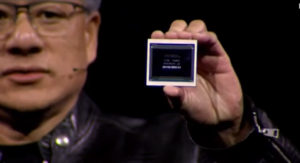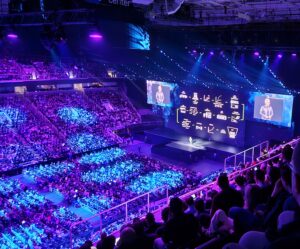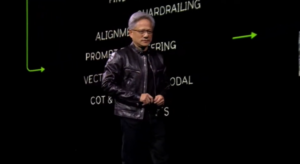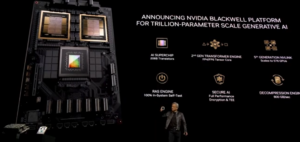
The Generative AI Future Is Now, Nvidia’s Huang Says

We are in the early days of a transformative shift in how business gets done thanks to the advent of generative AI, according to Nvidia CEO and cofounder Jensen Huang, who shared his vision for the future of computing today during his annual GPU Technology Conference keynote.
Traditional computing is all about retrieval, Huang said during his GTC keynote at the SAP Center in San Jose, California this afternoon. You grab your phone, press some buttons, a signal goes out, and you are presented with a piece of pre-recorded content, based on some recommendation system. Rinse and repeat.
That basic structure survived the end of Moore’s Law, which saw computational capacity doubling every five years. But that traditional model was flipped on its head the moment that ChatGPT showed us that computers can reliably generate content in an interactive fashion.
“You know that in the future, the vast majority of content will not be retrieved, and the reason for that is because it was pre-recorded by somebody who doesn’t understand the context, which is the reason why we had to retrieve so much content,” he said. “If you can be working with an AI that understand the context – who you are, for what reason you’re requesting this information–and produces the information for you, just the way you like it, the amount of energy you save, the amount of network and bandwidth you save, the waste of time you save, will be tremendous.
“The future is generative,” he continued, “which is the reason they call it generative AI, which is the reason why this is a brand new industry. The way we compute is fundamentally different.”
Trillions of Tokens
Huang hasn’t given a live, in-person keynote at GTC for five years, courtesy of COVID. Notoriously energetic, Huang didn’t disappoint an estimated 10,000 attendees, who crammed into the home of the San Jose Sharks NHL team to watch his two-hour presentation.
The show was vintage Huang and vintage Nvidia. It had all the video effects you would expect from a company that got its start powering high-end graphic chips, as well as the usual big announcements (a new Blackwell GPU, new AI software).
But the timing this time around is different, for about two trillion reasons. That’s the market capitalization (in dollars) of Nvidia, making it the third most valuable publicly traded company in the world behind Microsoft and Apple. It also may have contributed to the higher-than-normal level of security afforded to Huang, now one of the richest men in the world and no longer permitted to wander amid his adoring fan base.
Huang had the usual one-liners that brought the laughs (yes, we all sometimes talk to our GPUs as if they were dogs, and we can all relate to 3,000-pound carbon-fiber Ferraris). But what really resonated was Huang’s ambitious view of the future of computing and, at a larger level, the future of business as we know it.
“One-hundred-trillion dollars of the world’s industries are represented in this room today,” Huang marveled. “This is absolutely amazing.”
As the maker of the GPUs that are powering the generative AI revolution that’s currently playing out, Nvidia is in prime position to direct where it goes next. And Huang’s presentation made it clear that he intends to make his mark on all industries, from life sciences and healthcare to retail, manufacturing, logistics.
A New AI Industry
AlexNet and the identification of “cat” was the seed in 2014, but ChatGPT was the spark that ignited the current AI wildfire. As it spreads, it opens up new possibilities.
“As we see the miracle of ChatGPT emerge in front of us, we also realized we have a long ways to go,” Huang said. “We need even larger models. We’re going to train them with multi-modality data, not just text on the Internet, but we’re going to train them on text and images and graphs and charts–and just as we learned, by watching TV.”
Bigger models, of course, require bigger GPUs. Today’s introduction of the Blackwell GPU delivers a 5x increase in token generation, or inference, compared to the Hopper chip that it’s replacing at the top of Nvidia’s GPU totem pole. That extra capacity will enable companies to run current large language models (LLMs) and other AI models more efficiently. But that’s just the beginning, according to Huang. “We’re going to need a bigger GPU, even bigger than this one,” he said.
One of the solutions to the GPU size crunch is clustering. The latest state-of-the-art AI model, GPT-4, has about 1.8 trillion parameters, which required several trillion tokens to go train, Huang said. Training on a single GPU would take a thousand years, so Nvidia figured out a way to lash thousands of GPUs together over fast NVLink networks to make the cluster function as one.
The size of individual GPUs, as well as GPU clusters, surely will increase as bigger models emerge. Nvidia has a track record of delivering on that account, Moore’s Law or no.
“Over the course of the last eight years, we increased computing by 1,000 times” he said. “Remember back in the good old days of Moore’s Law, it was 10x every five years, 100 every 10 years. In the last eight years, we’ve gone up 1,000 times–and it’s still not fast enough! So we built another chip, NVLink Switch. It’s almost the size of Hopper all by itself!”
As the hardware counts increase, more data will be generated. Huang sees synthetic data being generated in simulators to provide even more feedstock to build and train newer, bigger, and better AI models.
“We’re using synthetic data generation. We’re using reinforcement learning,” he said. “We have AI working with AI, training each other, just like student-teacher debaters. All that is going to increase the size of the model, it’s going to increase the amount of data that we have, and we’re going to have to build even bigger GPUs.”
Picks for Digital Goldmines
It’s estimated that Nvidia currently owns 80% of the market for AI hardware, which is forecast to drive trillions in spending and generate trillions of dollars in value in the coming years. Even if that share decreases in the months and years to come, Nvidia will have an outsize influence on how GenAI gets done for the foreseeable future.
According to Huang, that means more data, bigger models, and more GPUs.
“In this industry, it’s not about driving down the cost of computing, it’s about driving up the scale of computing,” he said “We would like to be able to simulate the entire product that we do, complete in full fidelity, completely digitally, and essentially what we call digital twins.”
We’re still early into the GenAI revolution, Huang said. The movement started out with text and images (hello, kitty), but it’s by no means limited to those.
“The reason we started with text and images is because we digitized those. Well, what else have we digitized?” he said. “It turns out we’ve digitized a lot of things: proteins and genes and brain waves. Anything you can digitalize, so long as there’s structure, we can probably learn some patterns from it. If we can understand its meaning…we might be able to generate it as well. Therefore, the generative AI revolution is here.”
Every company with data now has the opportunity to monetize that data through GenAI. In addition to selling hardware, Nvidia is selling software designed to help them train and deploy models, including Nvidia AI Enterprise and the new Nvidia Inference Microservices (NIM) unveiled today.
By training that useful data on AI models, they can create co-pilots and chatbots that provide real value, according to Huang. “There are so many companies that … are sitting on a goldmine,” he said. “If they can take that goldmine and turn them into copilots, these capabilities can help us do things.
Ultimately, what seems to excite Huang is the newness of it all. The shift from retrieval-based computing to generative-based computing is a big one, and one that requires new hardware, new software, and likely new business models. The game is now playing out right before our eyes, and Nvidia is the key player in this new industry.
“Why is it a new industry?” Huang asked. “Because the software never existed before. We are now producing software, using computers to run software, producing software that never existed before. It’s a brand-new category. It took share from nothing.”
Related Items:
Nvidia Looks to Accelerate GenAI Adoption with NIM
Nvidia Bolsters RAPIDS Graph Analytics with NetworkX Expansion
GenAI Doesn’t Need Bigger LLMs. It Needs Better Data


































